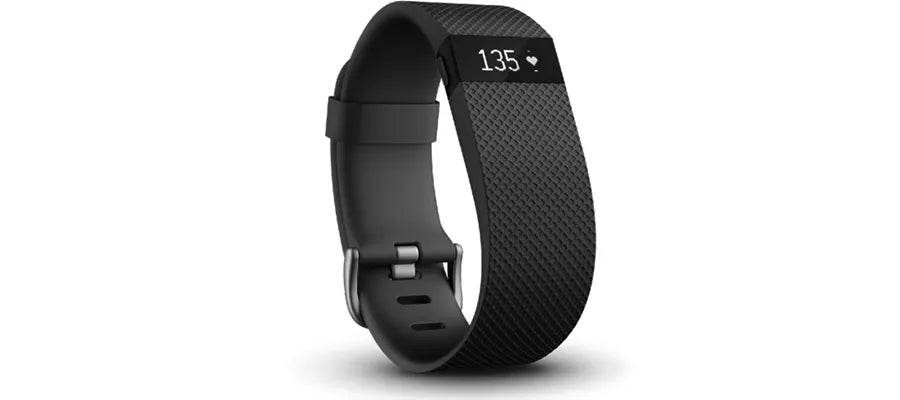
A Review of How the Fitbit Charge HR Tracks Your Sleep
Share
“Sleep Tracking Could be Improved."
Review: 3.5 Stars
While this fitness tracker is one of the most popular on the market, it’s ability to track sleep patterns could be better.
You’ve heard of the Fitbit, right? Sure you have. Your mother probably has one already. They are a publicly traded company with a slew of fitness trackers that have gained massive popularity over the past few years. They have commercials, they’re sold at Costco, and they even sponsor a new fitness TV reality show. We put the Fitbit Charge HR to the test to see how it performs the task of tracking your sleep.
The iPhone App
With any sleep tracker, the vital component to actually seeing your sleep data is your phone. The interface to see how well you slept the previous night is pretty good. It’s very simple and easy to understand. However it truly is simplified – what you see is what you get. There are no advanced metrics and you don’t have the ability to see REM sleep (although we are still skeptical that any fitness wearable actually tracks your REM sleep very well.)
You can set a sleep goal for yourself at whatever hour limit you want. We tested ours with a goal of 7 hours sleep per night. You get a nice star when you reach that goal, making it easy to see when you reach your goal.
You can also log your own sleep “fall asleep time” and “wake up” time if you feel the tracker didn’t do it right (or if you forgot to wear it). You’ll notice in the image below that there are two days missing from chart. This wasn’t because the Fitbit wasn’t worn – it simply didn’t track sleep for two nights in a row. We’ll address that further down the article.
Pros
It’s Lighter Than it Looks
When you first see the Fitbit Charge HR on someone else’s wrist, it looks like a substantial piece of hardware. The watch style band makes this fitness tracker seem like it’s going to be pretty heavy on your wrist. However to our surprise, it was extremely light. This is a big benefit when wearing it to sleep. Having to wear a heavy watch to bed every night isn’t exactly conducive to a comfortable night in bed.
It’s Super Easy to Use
Setting up the Fitbit Charge HR was a breeze. Connecting to the app and getting it up and running is very easy. It also doesn’t require you to do anything in order to track your sleep. You just wear it to bed and it automatically tracks everything for you. If you’re someone who can’t always remember to do things, then this feature is truly nice. Just wear it all day and it will be tracking.
Cost – $149
The cost of the Fitbit Charge HR is not too bad (and it’s actually only $127 on Amazon) – what you’re really paying for is the heart rate monitor. Not all trackers have a heart rate monitor, therefore the price is usually cheaper. This model constantly monitors your heart rate with an unobtrusive green sensor light underneath the tracker. Overall, the cost isn’t too bad for the quality and the features that the Charge HR offers.
Cons
You Can’t Turn Sleep Mode On Manually
Having your Charge HR track your sleep automatically is really nice. However, when we tested it – it missed two whole nights of sleep! If we had the ability to turn sleep mode on, then the Charge HR would have tracked our sleep those nights. This was a bit frustrating and in our opinion.
You Can’t Track Naps Shorter Than 1 Hour
Most experts recommend that getting a short nap during the day is good for you. Also, most experts recommend the duration of your nap stay under 1 hour. Well, since the Charge HR can’t be put into sleep mode manually, then you can’t track how well you slept during your nap if it lasts under one hour.
No REM Sleep Tracking
The Fitbit Charge HR gives you three different “states” of your sleep pattern: Asleep, Restless and Awake. REM sleep is not tracked. Nor is there a clear distinction between light and deep sleep. We can assume that Asleep and Restless are comparable to deep and light sleep, but it’s tough to say.
Overall, the Fitbit Charge HR is a good fitness tracker. However if you’re looking to really track the quality of your sleep, then I would suggest going with a different wearable. There are several other trackers on the market that take a deeper dive into your sleep stats and offer a few nicer sleep based options as well. For instance, the Jawbone lets you turn on sleep mode whenever you want – and it also has a nice “power-nap” feature.
The biggest benefit to the Fitbit is probably their huge community of users. This lets you challenge friends and family with activity based goals – like most steps in a week. We all know that competition can be be helpful when trying to lose weight or get fit, so the “friends” feature is a solid plus for this fitness tracker.